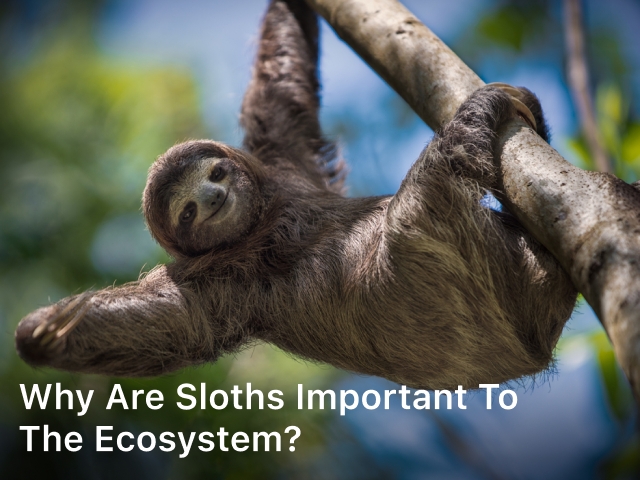Why are Sloths Important to The Ecosystem?

Dive into understanding why Sloths are Important to The Ecosystem. Uncover their role in habitat preservation and promoting biodiversity. Explore now!
Sloths may seem like unassuming creatures, spending most of their time sleeping in trees, but they play a crucial role in maintaining the health of their surrounding ecosystem. These fascinating animals are known for their slow movements and leisurely lifestyles, but they contribute to the survival of a diverse range of plant and animal species.
Through their interactions with their environment, sloths support vital ecological processes such as seed dispersal, algae symbiosis, and predation control. Sloths also provide economic benefits through their contribution to ecotourism, which can incentivize local communities to protect sloth habitats.
Why are Sloths Important to The Ecosystem
Key Takeaways:
- Sloths are vital for habitat preservation and maintaining biodiversity
- They play a unique role as keystone species in their environment
- Sloths indirectly protect a wide range of other species by preserving their habitats
- Sloths contribute to seed dispersal, helping to regenerate and diversify plant populations
- The symbiotic relationship between sloths and algae benefits both species and contributes to nutrient cycling in the ecosystem
Sloths as Keystone Species
Sloths play a crucial role as keystone species in their environment. As slow-moving animals, they rely on specific trees and vegetation for their survival. But their influence extends beyond their immediate needs.
Sloths help to maintain the balance of their habitat, playing a unique role in shaping the structure and function of the ecosystem as a whole. They have a profound effect on their environment, despite their indolent behavior.
Because sloths are reliant on specific trees and vegetation for their survival, they are critical players in shaping their habitat. Their browsing behavior impacts the distribution and growth of vegetation, promoting a more diverse and balanced ecosystem.
Furthermore, sloths are prey animals, and their presence in an ecosystem affects predator-prey dynamics. By limiting the number of sloth prey species, they indirectly control the population of their predators, thus helping to maintain a balanced ecosystem.
In summary, sloths are essential keystone species in their environment, with a unique impact on maintaining the balance of their habitat and influencing the structure and function of the ecosystem as a whole.

Sloths and Habitat Preservation
Sloths are habitat specialists, relying on specific trees and vegetation for sustenance and survival. By preserving the habitats where sloths reside, we indirectly protect a wide range of other species that share the same ecosystem.
The preservation of sloth habitat is crucial since these arboreal creatures play a pivotal role in the balance and stability of the forest’s ecosystem. Sloths live in symbiosis with other species, including algae, fungi, and insects, that are essential components of their habitat. The loss of sloth habitat would mean the loss of the crucial ecological functions dependent on them.
Sadly, sloth habitat is under threat from human activities such as deforestation, poaching, and mining. The destruction of sloth habitats leads to habitat fragmentation, resulting in reduced biodiversity and the loss of important ecosystem services. To prevent the loss of sloth habitat, we must focus on conservation efforts that involve habitat restoration, land-use planning, and responsible use of natural resources.
Sloths and Seed Dispersal
Sloths, with their slow movements and unique feeding habits, play a crucial role in seed dispersal within the ecosystem. As sloths consume leaves and fruits from trees, they ingest and carry seeds in their digestive tracts. Sloths travel significant distances and deposit seeds in their droppings throughout their journeys. This process of seed dispersal is essential for the regeneration and diversification of plant populations.
In addition to distributing seeds, sloths’ feeding patterns also help to create gaps in the canopies of trees, allowing sunlight to reach the forest floor. This change in light conditions, in turn, allows understory vegetation to grow and thrive. By doing so, sloths contribute to the overall biodiversity and health of the ecosystem.
“Sloths are considered one of the most important group of frugivores in the Neotropics since they can consume and disperse a wide variety of plant species.”
Sloths and Algae Symbiosis
Sloths have a unique relationship with algae, which often grows on their fur. This symbiotic partnership provides camouflage and additional nutrients for the sloths while benefiting the algae by providing a habitat. The two organisms have evolved to work together, with the algae using sloth fur as a platform for growth and the sloths gaining additional nutrients from the algae.
This symbiosis has a significant impact on the ecosystem as a whole. The accumulation of algae on sloth fur provides a source of nutrients for other organisms, and the decomposition of dead algae can release nutrients back into the ecosystem. Additionally, the algae on sloths contributes to nutrient cycling in the ecosystem, contributing to the overall health of the ecosystem.
The symbiosis also helps to promote the growth of other organisms in the ecosystem. When sloths move between trees, they inadvertently transfer algae from one tree to another, allowing algae to colonize new areas and diversifying the plant population.
The relationship between sloths and algae is an essential component of the ecosystem, demonstrating the interconnectedness of all organisms. The conservation of sloth populations is crucial for ensuring the continuation of this important symbiotic relationship.
Sloths and Predation Control
Sloths are not only known for their slow movements but also for their ability to evade predators. Many predators, such as jaguars, harpy eagles, and anacondas, hunt sloths, but their low population density and cryptic behavior make them a challenging prey.
Despite their low reproductive rate, sloths play a crucial role in the food chain as prey for predators. However, by limiting the number of sloth prey species, sloths indirectly control the population of their predators, thus helping to maintain a balanced ecosystem.
Furthermore, sloths’ presence in the ecosystem contributes to a healthy and diverse food web, as predators that rely on sloths also impact other species’ populations. By serving as prey, sloths indirectly regulate the population growth of numerous species.
Therefore, sloths have a significant impact on the ecosystem by acting as a buffer against population explosions of their predators and indirectly controlling the population growth of other species in the food chain.
In conclusion, sloths may seem like slow and unassuming creatures, but their impact on the ecosystem’s health cannot be overstated. As keystone species, sloths contribute to preserving habitats and promoting biodiversity, serving as seed dispersers, providing algae with a habitat, and playing a role in predation control. Understanding their significance is crucial to ensuring the overall health of our natural world.
Sloths and Ecotourism
Sloths are fascinating and unique animals that have become increasingly popular among tourists in recent years. Their slow movements, adorable faces, and unusual behaviors make them a draw for many eco-tourists who seek out opportunities to observe them in their natural habitats.
Eco-tourism centered around sloths not only provides visitors with a rare and memorable experience but also generates much-needed revenue for local communities. Tourists who come to see sloths typically require food and lodging, translating to economic benefits for the surrounding areas. Additionally, sloth-centric tours and conservation efforts help to preserve the ecosystems where sloths live, ultimately contributing to wider conservation efforts.
Despite this, it is crucial to approach sloth ecotourism responsibly to minimize negative impacts on these animals and their environments. Tour groups should adhere to strict guidelines to avoid disturbing or harming sloths, and visitors should ensure that they visit reputable operators. By doing so, we can continue to enjoy the beauty of these creatures while contributing to their conservation.
Sloths and Their Crucial Role in the Ecosystem
Sloths are fascinating creatures with a vital role in the ecosystem. Understanding their importance is crucial for promoting biodiversity and ensuring the overall health of our natural world.
Sloths as Keystone Species
Sloths play a critical role as keystone species in their habitat. They have a unique impact on maintaining the balance of their environment, influencing the structure and function of the ecosystem as a whole.
Sloths and Habitat Preservation
Sloths are known to be habitat specialists, relying on specific trees and vegetation for survival. By preserving the habitats where sloths reside, we indirectly protect a wide range of other species that share the same ecosystem.
Sloths and Seed Dispersal
Sloths play a vital role in seed dispersal due to their slow movements and feeding habits. As they consume tree leaves and fruits, they inadvertently spread seeds through their droppings, helping to regenerate and diversify plant populations.
Sloths and Algae Symbiosis
Sloths have a unique relationship with algae, which often grows on their fur. This symbiotic partnership provides camouflage and additional nutrients for the sloths while benefiting the algae by providing a habitat. Algae on sloths also contribute to nutrient cycling in the ecosystem.
Sloths and Predation Control
Sloths have evolved to be elusive and slow-moving, making them a challenging prey for predators. By limiting the number of sloth prey species, they indirectly control the population of their predators, thus helping to maintain a balanced ecosystem.
Sloths and Ecotourism
The presence of sloths in various ecosystems attracts tourists who wish to observe these unique creatures. Ecotourism centered around sloths provides economic incentives for local communities to protect the habitats where sloths thrive, ultimately contributing to ecosystem conservation.
Why are sloths so important to the rainforest?
Sloths play several important roles in the rainforest ecosystem, despite their slow and seemingly lethargic behavior. Here are some reasons why sloths are important to the rainforest:
Seed Dispersal: Sloths are known to eat a variety of fruits and leaves from different trees in the rainforest. As they move from tree to tree, they often drop partially eaten fruits and leaves, which can germinate and grow into new plants. This helps in seed dispersal, contributing to the biodiversity and regeneration of the forest.
Nutrient Cycling: Sloths are herbivores, and their diet consists mainly of leaves. They have a slow digestive system that allows them to extract nutrients efficiently from their food. When they defecate, the nutrients from the leaves are returned to the soil in a more accessible form, enhancing soil fertility. This, in turn, benefits the growth of vegetation in the rainforest.
Habitat for Other Species: Sloths provide habitat and resources for other organisms. Algae often grow on their fur, which provides camouflage and additional food for other animals like moths and insects. These in turn may attract predators, creating a complex web of interactions in the rainforest ecosystem.
Biodiversity: Sloths are prey for a variety of rainforest predators, including harpy eagles, jaguars, and large snakes. Their presence in the food chain contributes to the biodiversity of the rainforest, supporting the populations of these predators and helping to maintain a balanced ecosystem.
Tourism and Conservation: Sloths are charismatic and intriguing creatures, making them popular attractions for ecotourism in rainforest regions. Tourism revenue can support conservation efforts and help raise awareness about the importance of preserving these ecosystems.
Indicator Species: Sloths are sensitive to changes in their environment, particularly deforestation and habitat degradation. Their population health can serve as an indicator of the overall health of the rainforest. A decline in sloth populations can signal broader ecological problems in the region.
In summary, sloths are integral to the functioning of the rainforest ecosystem through their contributions to seed dispersal, nutrient cycling, habitat provision, and as part of the food web. Protecting sloth populations and their habitats is essential for the overall health and diversity of the rainforest.
Conclusion
In conclusion, sloths play a crucial role in the ecosystem through their interactions with their environment, including habitat preservation, seed dispersal, algae symbiosis, predation control, and their contribution to ecotourism. By protecting sloths and their habitats, we can indirectly protect many other species and ensure the overall health of our natural world.
FAQ
Q: Why are sloths important to the ecosystem?
A: Sloths are important to the ecosystem for several reasons. They play a role as keystone species, contribute to habitat preservation, aid in seed dispersal, have a symbiotic relationship with algae, help control predation, and contribute to ecotourism.
Q: What is the significance of sloths as keystone species?
A: Sloths are considered keystone species because they have a unique impact on maintaining the balance of their habitat. They influence the structure and function of the ecosystem as a whole.
Q: How do sloths contribute to habitat preservation?
A: Sloths are habitat specialists, relying on specific trees and vegetation for survival. By preserving the habitats where sloths reside, we indirectly protect a wide range of other species that share the same ecosystem.
Q: What role do sloths play in seed dispersal?
A: Sloths play a vital role in seed dispersal due to their slow movements and feeding habits. As they consume tree leaves and fruits, they inadvertently spread seeds through their droppings, helping to regenerate and diversify plant populations.
Q: How do sloths interact with algae?
A: Sloths have a unique relationship with algae, which often grows on their fur. This symbiotic partnership provides camouflage and additional nutrients for the sloths while benefiting the algae by providing a habitat. Algae on sloths also contribute to nutrient cycling in the ecosystem.
Q: How do sloths help control predation?
A: Sloths have evolved to be elusive and slow-moving, making them a challenging prey for predators. By limiting the number of sloth prey species, they indirectly control the population of their predators, thus helping to maintain a balanced ecosystem.
Q: How do sloths contribute to ecotourism?
A: The presence of sloths in various ecosystems attracts tourists who wish to observe these unique creatures. Ecotourism centered around sloths provides economic incentives for local communities to protect the habitats where sloths thrive, ultimately contributing to ecosystem conservation.
Q: What is the conclusion regarding the importance of sloths in the ecosystem?
A: Sloths play a crucial role in the ecosystem through their interactions with their environment, including habitat preservation, seed dispersal, algae symbiosis, predation control, and their contribution to ecotourism. Understanding the importance of sloths in the ecosystem is vital for promoting biodiversity and ensuring the overall health of our natural world.





